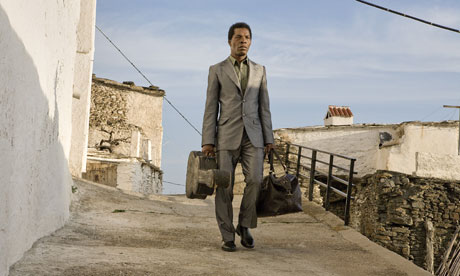
The Limits of Control
Jim Jarmusch sets his latest enigma in Madrid, Seville and Almería. Existentialist mystery ensues…
Philip French Critic of the year
-
- The Observer, Sunday 13 December 2009
- Article history
 Isaach De Bankolé in The Limits of Control.
Isaach De Bankolé in The Limits of Control. Jim Jarmusch has been writing and directing intriguing, highly accomplished independent movies for a quarter of a century now and occasionally acting in those of fellow independents. His budgets remain relatively modest by Hollywood standards, but he has attracted leading performers like Johnny Depp and Robert Mitchum to work with him, as well as musicians such as Tom Waits and Joe Strummer.
- The Limits of Control
- Production year: 2009
- Country: Rest of the world
- Cert (UK): 15
- Runtime: 116 mins
- Directors: Jim Jarmusch
- Cast: Alex Descas, Bill Murray, Gael Garcia Bernal, Isaach de Bankole, John Hurt, Paz de la Huerta, Tilda Swinton
His films are mysterious without being obscure and are sometimes carefully patterned and sometimes linear stories of journeys of discovery. Mystery Train, for instance, retraces the same few hours as it interweaves several stories of Presley fans in Memphis, while in Broken Flowers Bill Murray crisscrosses America visiting old girlfriends (all played by well-known actresses) to discover which one bore him a son. Despite the fact that few of the characters actually meet each other, there's always a sense of ensemble acting in Jarmusch's work and this is true of his hypnotic new picture The Limits of Control.
Isaach De Bankolé, the black French actor from the Ivory Coast making his fourth film with Jarmusch, travels around Spain encountering a dozen people played by familiar actors from a dozen countries ranging from Japan to Palestine, none of whom appears to know of the others' existence. The movie is something of a homage to John Boorman's dreamlike thriller Point Blank (it's actually announced as "A Point Blank production") and is much influenced in its themes and settings by Melville's Le samouraï, Antonioni's The Passenger and the conspiracy pictures of Jacques Rivette.
No one has a name. Bankolé, identified in the credits as "Lone Man", belongs in that tradition of professional hitmen who have fascinated writers and film-makers from Shakespeare (the Murderers in Richard III and Macbeth) through Graham Greene (A Gun for Sale) and Jean Paul-Sartre (Les mains sales) to Michael Mann (Collateral). Forest Whitaker played such a figure in Jarmusch's Ghost Dog: The Way of the Samurai, and while Bankolé also seems attracted to eastern ways (he begins the day with tai chi), he's an existential figure about whom we know nothing beyond his few laconic statements and his behaviour.
He's dispatched on a mission by two Frenchmen, one black, one white, in an airport lounge, who begin their briefing with the question: "You don't speak Spanish, right?", which becomes both recognition code and mantra. As with his later contacts, they exchange matchboxes, alternately red and green, from a brand called Le Boxeur, the one he receives always containing a small, encrypted message which he chews and swallows. He first flies to Madrid, where he stays in a famous high-rise apartment block that looks like a Bauhaus reworking of Gaudi. Wherever he goes, he orders two separate espressos, an indication of his rigid sense of control, and makes contact according to oblique instructions.
From Madrid, he takes the train to Seville, where his backstreet apartment in the old town is in a different, more traditional style. Another train takes him to rural Almería, where he stays in a ghost town near his target, a closely guarded fortress belonging to some powerful international organisation, possibly connected to the helicopters that hover everywhere.
Along the way, the Lone Man meets a variety of colourful characters, all of a philosophical bent, who have to be reminded of their essential roles in some conspiratorial enterprise, at which we can only guess. My hunch is that we're watching the revenge of the downtrodden upon globalism and capitalist society. The film's one demon is called simply "the American". Death and disorientation are much in the air.
The only time Bankolé faintly smiles is when he watches a flamenco singer and dancer in Seville and several times he is directed to a grand art gallery in Madrid to interrogate a cubist painting by Juan Gris of a violin, an erotic 1920s nude by Roberto Balbuena and, at the end, an all-white painting by Antonie Tàpies of a sheet nailed to a canvas. There are numerous clues in this delightfully ludic, enigmatic film to suggest we're experiencing a dream or watching a film about film. For example, the hero flies by Air Lumière and an exotic cinephile dressed all in white (Tilda Swinton) tells him she loves old films because they capture a vanished past, that in her memory she can't distinguish dreams from films and that she loves watching movies where people just sit around and nothing happens.
The Limits of Control is a picture people will love or loathe, though no one could fail to be impressed by the haunted, surreal atmosphere that is rendered by the brilliant Hong Kong-based Australian cinematographer Christopher Doyle. I was riveted from the moment I read the epigraph from Arthur Rimbaud's "Le bateau ivre": "As I descended into impassable rivers/ I no longer felt guided by the ferryman."
No comments:
Post a Comment